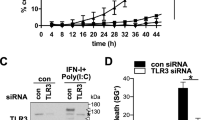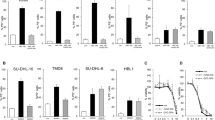Abstract
In the present study we have shown that the cancer therapeutic drug, daunorubicin, induces apoptosis in the human lymphoblastic leukemia cell line Jurkat E6.1. This effect was both dose- and time-dependent with nuclear fragmentation detectable by 8 h. Caspases have been implicated in pro-apoptotic events. By utilizing synthetic fluorochrome-linked substrates of the caspases, we observed that a caspase-3-like enzyme had dramatically increased activity (3340 ± 130% with respect to basal levels) in response to daunorubicin treatment. Furthermore, by using an inhibitor to caspase-3, Ac-DEVD-CHO, we have shown that activation of a caspase-3-like enzyme appears to be necessary for nuclear fragmentation and apoptotic body formation, but is not required for chromatin condensation. In contrast, a general caspase inhibitor, Z-VAD-fmk, inhibited all apoptotic parameters measured. Ceramide has been implicated in daunorubicin-induced apoptosis in human myeloid leukemia cells. However, in Jurkat cells, caspase activation does not appear to be a consequence of ceramide generation since, although ceramide levels were elevated through the action of ceramide synthase in response to daunorubicin treatment, this occurred with slower kinetics than either nuclear fragmentation or caspase activation. In contrast, caspase inhibitors abrogated ceramide elevation induced by DNR treatment, suggesting that ceramide synthase may be a downstream target for caspase action. Therefore, daunorubicin-induced apoptosis does not appear to be mediated by ceramide in the lymphoblastic leukemia cell line, Jurkat E6.1. Instead, caspase 3 activity appears to be necessary, but not sufficient for this process.
This is a preview of subscription content, access via your institution
Access options
Subscribe to this journal
Receive 12 print issues and online access
$259.00 per year
only $21.58 per issue
Buy this article
- Purchase on Springer Link
- Instant access to full article PDF
Prices may be subject to local taxes which are calculated during checkout
Similar content being viewed by others
Author information
Authors and Affiliations
Rights and permissions
About this article
Cite this article
Turnbull, K., Brown, B. & Dobson, P. Caspase-3-like activity is necessary but not sufficient for daunorubicin-induced apoptosis in Jurkat human lymphoblastic leukemia cells. Leukemia 13, 1056–1061 (1999). https://doi.org/10.1038/sj.leu.2401438
Received:
Accepted:
Published:
Issue Date:
DOI: https://doi.org/10.1038/sj.leu.2401438
Keywords
This article is cited by
-
Intrinsic and extrinsic apoptosis responses in leukaemia cells following daunorubicin treatment
BMC Cancer (2021)
-
Tumor suppressive functions of ceramide: evidence and mechanisms
Apoptosis (2015)
-
Mechanisms of induction of apoptosis by anthraquinone anticancer drugs aclarubicin and mitoxantrone in comparison with doxorubicin: Relation to drug cytotoxicity and caspase-3 activation
Apoptosis (2005)
-
Fenretinide stimulates redox-sensitive ceramide production in breast cancer cells: potential role in drug-induced cytotoxicity
British Journal of Cancer (2004)
-
Human growth hormone gene transfer into tumor cells may improve cancer chemotherapy
Cancer Gene Therapy (2002)



